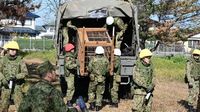Japan is grappling with a crisis that few could have predicted: a record-breaking surge in bear attacks that has left communities in the northern prefecture of Akita on edge and forced the government to deploy troops for the first time in an effort to keep residents safe. The unprecedented move, which began on November 5, 2025, comes after a year marked by a dramatic rise in encounters between humans and bears—encounters that have turned deadly with alarming frequency.
According to the Environment Ministry, since April 2025, more than 100 people have been injured and at least 12 killed in bear attacks across Japan. But the full scope of the problem is even more staggering. As reported by The Asahi Shimbun, the number of people harmed by bears in 2023 was 219—a record at the time. By the end of October 2025, 196 cases had already been reported, and attacks continued into November, particularly in the Tohoku region. Akita Prefecture has borne the brunt of the crisis, with 37 victims in October alone, far outpacing neighboring Iwate, Fukushima, and Gunma prefectures.
This wave of attacks has not been confined to remote forests. Bears have been spotted near schools, train stations, supermarkets, and even at a hot springs resort, according to the Associated Press. In one particularly harrowing incident, a resident of Akita city filmed two bears as they climbed a persimmon tree in her garden and appeared to consider entering her home. She told a local TV network that the bears lingered for about 30 minutes, prompting her to move away from the window for her own safety.
The Defense Ministry’s deployment, coordinated with Akita Prefecture, is a multifaceted operation. Division Commander Yasunori Matsunaga and Governor Kenta Suzuki signed a formal agreement on November 5, 2025, outlining the troop’s mission: setting box traps, conducting patrols, transporting hunters, moving captured or culled bears, and collecting information. Importantly, the troops are not authorized to use firearms. Instead, they rely on bear repellent spray and net launchers for deterrence and protection. The mission, based at the Ground Self-Defense Force (GSDF) Akita Garrison, is scheduled to continue until November 30, 2025.
“Every day, bears intrude into residential areas in the region and their impact is expanding,” Deputy Chief Cabinet Secretary Fumitoshi Sato told reporters, emphasizing the urgency of the government’s response. Governor Suzuki acknowledged the complexity of the deployment, stating, “It wasn’t clear what the SDF would do, so detailed adjustments were necessary. But we reached an agreement in about a week and I’m grateful.” He also stressed that this deployment is an exception, not a precedent for future wildlife incidents involving the Self-Defense Forces.
The operation began in Kazuno city, a forested area where bear sightings and injuries have been especially frequent. White-helmeted soldiers, clad in bulletproof vests and armed with bear spray, set up traps near orchards and other likely bear haunts. Takahiro Ikeda, an orchard operator, described the toll the bears have taken: “Bears have eaten more than 200 of my apples that were ready for harvest. My heart is broken,” he told NHK television.
Akita’s rural communities are particularly vulnerable. The region’s population is aging and shrinking, leaving fewer people able—or willing—to hunt bears. Experts cited by the Associated Press and The Asahi Shimbun note that many local hunters are elderly and not accustomed to bear hunting, while the number of trained hunters is simply insufficient for the scale of the problem. This has led to calls for police and other authorities to be trained as "government hunters" to help control the bear population.
The government estimates that Japan’s overall bear population now exceeds 54,000. The lack of preventive measures in the northern regions has allowed the population to grow unchecked, further exacerbating the risk to humans. Once bears find food in abandoned neighborhoods or farmlands dotted with persimmon and chestnut trees, they tend to return, experts warn.
The human cost of this crisis is all too real. On November 3, 2025, the body of a 79-year-old woman was found in a forest in Yuzawa city—she had gone mushroom picking the previous morning and was later reported missing. Police suspect she was killed by a bear, as her body showed multiple bite marks. Just hours earlier, a 65-year-old man was attacked by a mother bear and her cub in a residential area of Akita, suffering facial injuries. That same morning in Daisen, a man in his 70s was injured in another bear attack while walking. The following day, a 77-year-old newspaper delivery man was mauled in his own yard in Akita city. He managed to escape by crouching defensively until the bear left, but sustained injuries near his right eye and right hand.
Bear encounters have disrupted daily life in other ways, too. On November 4, 2025, Akita city conducted its first emergency bear removal using firearms after a bear was spotted at Round1 Stadium Akita, an entertainment complex. Authorities used a tranquilizer gun to cull the 1.28-meter male bear, prioritizing public safety. The crisis has even impacted major events: the Tohoku high school ekiden (long-distance relay race) championship, scheduled for November 6, 2025, in Akita, was forced to switch from a road race to a track event due to repeated bear sightings along the course. Gakuho Ishikawa Senior High School from Fukushima withdrew altogether, citing safety concerns. “I feel sorry for the runners who were supposed to compete, but safety comes first,” said Coach Kazuhiro Matsuda, explaining the decision after consulting with his athletes.
In response to the escalating situation, the government established a task force in early November to develop a comprehensive bear response strategy by mid-month. Measures under consideration include bear population surveys, improved communication devices to issue bear warnings, and revisions to hunting rules. The task force aims to balance public safety with the realities of Japan’s changing demographics and wildlife management challenges.
Defense Minister Shinjiro Koizumi has made it clear that while the military’s involvement is vital for now, their primary mission remains national defense. “We cannot provide unlimited support for the bear response,” he stated, noting that the Self-Defense Forces are already understaffed and that no other prefectures have requested troop assistance for similar issues.
Japan’s struggle with bear attacks is a stark reminder of the complex relationship between humans and wildlife—one that is being reshaped by demographic changes, environmental pressures, and shifting patterns of land use. As the government races to formulate a sustainable response, residents of Akita and beyond are left hoping that a balance can be struck before the next bear encounter turns tragic.






